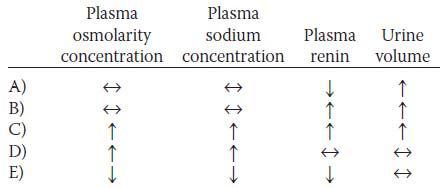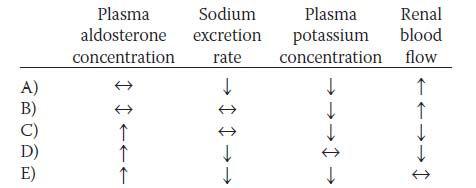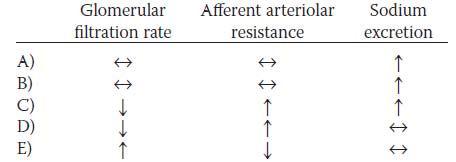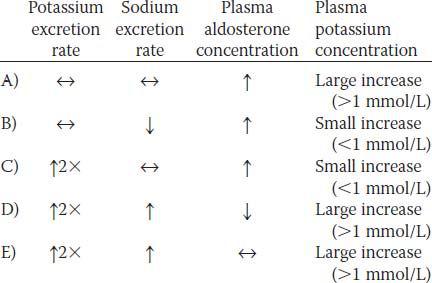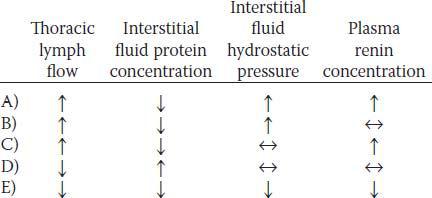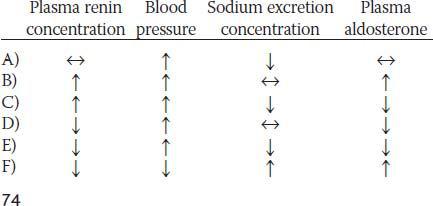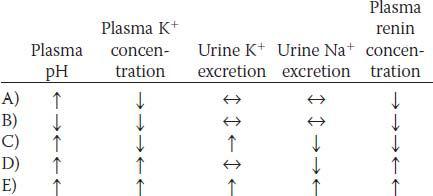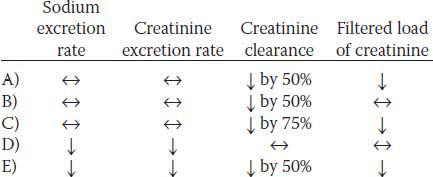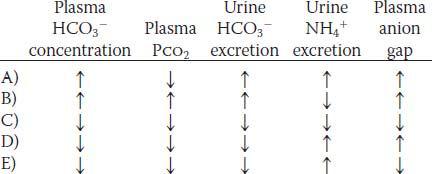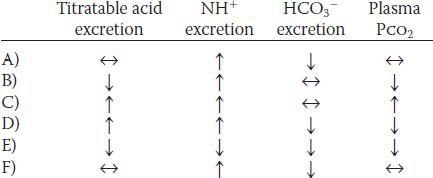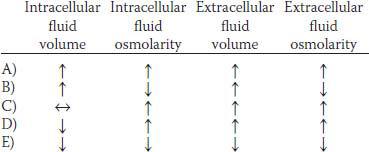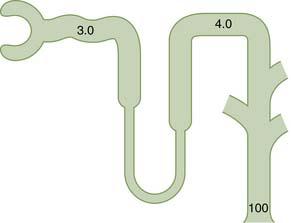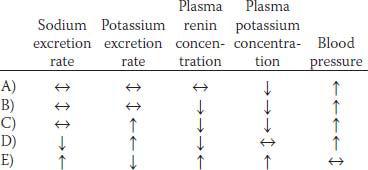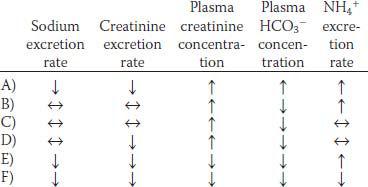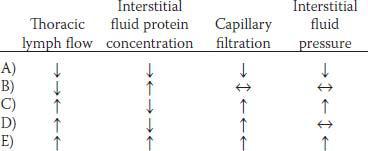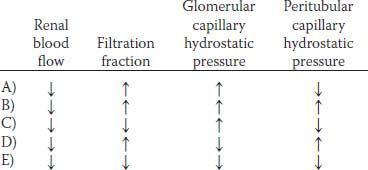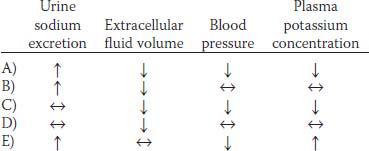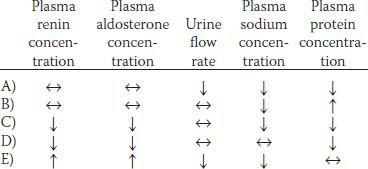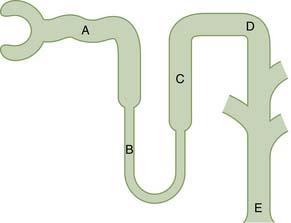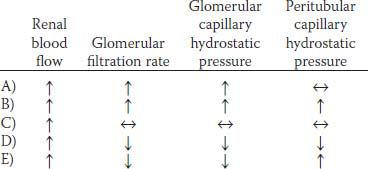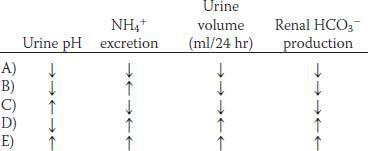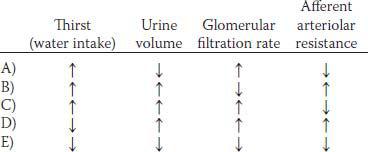The diagrams represent various states of abnormal hydration. In each diagram, the normal state (orange and lavender) is superimposed on the abnormal state (dashed lines) to illustrate the shifts in the volume (width of rectangles) and total osmolarity (height of rectangles) of the extracellular and intracellular fluid compartments.
7.
Which of the diagrams represents the changes (after osmotic equilibrium) in extracellular and intracellular fluid volumes and osmolarities after the infusion of 1% dextrose?
8.
Which of the diagrams represents the changes (after osmotic equilibrium) in extracellular and intracellular fluid volumes and osmolarities after the infusion of 3% sodium chloride?
9.
Which of the diagrams represents the changes (after osmotic equilibrium) in extracellular and intracellular fluid volumes and osmolarities in a patient with the syndrome of inappropriate antidiuretic hormone (excessive secretion of antidiuretic hormone)?
10.
After receiving a renal transplant, a patient develops severe hypertension (170/110 mm Hg). A renal arteriogram indicates severe renal artery stenosis in his single remaining kidney, with a reduction in GFR to 25% of normal. Which of the following changes, compared with normal, would be expected in this patient, assuming steady-state conditions?
A) Large increase in plasma sodium concentration
B) Reduction in urinary sodium excretion to 25% of normal
C) Reduction in urinary creatinine excretion to 25% of normal
D) Increase in serum creatinine to about four times normal
E) Normal renal blood flow in the stenotic kidney due to autoregulation
11.
Which of the following tends to decrease potassium secretion by the cortical collecting tubule?
A) Increased plasma potassium concentration
B) A diuretic that decreases proximal tubule sodium reabsorption
C) A diuretic that inhibits the action of aldosterone (e.g., spironolactone)
12.
If a patient has a creatinine clearance of 90 ml/min, a urine flow rate of 1 ml/min, a plasma K
+ concentration of 4 mEq/L, and a urine K
+ concentration of 60 mEq/L, what is the approximate rate of K
+ excretion?
13.
Which of the following changes would be expected in a patient with diabetes insipidus due to a lack of antidiuretic hormone (ADH) secretion?
14.
A patient with severe hypertension (blood pressure 185/110 mm Hg) is referred to you. A renal magnetic resonance imaging scan shows a tumor in the kidney, and laboratory findings include a very high plasma renin activity of 12 ng angiotensin 1/ml/hr (normal = 1). The diagnosis is a renin-secreting tumor. Which of the following changes would you expect to find in this patient, under steady-state conditions, compared with normal?
15.
Which of the following changes, compared with normal, would you expect to find 3 weeks after a patient ingested a toxin that caused sustained impairment of proximal tubular sodium chloride (NaCl) reabsorption? Assume that there has been no change in diet or ingestion of electrolytes.
16.
A 26-year-old woman recently decided to adopt a healthier diet and eat more fruits and vegetables. As a result, her potassium intake increased from 80 to 160 mmol/day. Which of the following conditions would you expect to find 2 weeks after she increased her potassium intake, compared with before the increase?
17.
An 8-year-old boy is brought to your office with extreme swelling of the abdomen. His parents indicate that he had a very sore throat a “month or so” ago and that he has been “swelling up” since that time. He appears to be edematous, and when you check his urine, you find large amounts of protein being excreted. Your diagnosis is nephrotic syndrome subsequent to glomerulonephritis. Which of the following changes would you expect to find, compared with normal?
18.
Which of the following changes would you expect to find after administering a vasodilator drug that caused a 50% decrease in afferent arteriolar resistance and no change in arterial pressure?
A) Decreased renal blood flow, decreased GFR, and decreased peritubular capillary hydrostatic pressure
B) Decreased renal blood flow, decreased GFR, and increased peritubular capillary hydrostatic pressure
C) Increased renal blood flow, increased GFR, and increased peritubular capillary hydrostatic pressure
D) Increased renal blood flow, increased GFR, and no change in peritubular capillary hydrostatic pressure
E) Increased renal blood flow, increased GFR, and decreased peritubular capillary hydrostatic pressure
19.
A 32-year-old man complains of frequent urination. He is overweight (280 lb, 5 ft 10 in tall), and after measuring the 24-hr creatinine clearance, you estimate his GFR to be 150 ml/min. His plasma glucose is 300 mg/dL. Assuming that his renal transport maximum for glucose is normal, as shown in the figure above, what would be this patient’s approximate rate of urinary glucose excretion?
F) Information provided is inadequate to estimate the glucose excretion rate
20.
The clinical laboratory returned the following values for arterial blood taken from a patient: plasma pH = 7.28, plasma HCO
3− = 32 mEq/L, and plasma Pco
2 = 70 mm Hg. What is this patient’s acid–base disorder?
A) Acute respiratory acidosis without renal compensation
B) Respiratory acidosis with partial renal compensation
C) Acute metabolic acidosis without respiratory compensation
D) Metabolic acidosis with partial respiratory compensation
21.
Which of the following changes tends to increase peritubular capillary fluid reabsorption?
A) Increased blood pressure
B) Decreased filtration fraction
C) Increased efferent arteriolar resistance
D) Decreased angiotensin II
E) Increased renal blood flow
22.
Which of the following would cause the greatest degree of hyperkalemia?
A) Increase in potassium intake from 60 to 180 mmol/day in a person with normal kidneys and a normal aldosterone system
B) Chronic treatment with a diuretic that inhibits the action of aldosterone
C) Decrease in sodium intake from 200 to 100 mmol/day
D) Chronic treatment with a diuretic that inhibits loop of Henle Na+-2Cl−-K+ co-transport
E) Chronic treatment with a diuretic that inhibits sodium reabsorption in the collecting ducts
23.
Which of the following is filtered most readily by the glomerular capillaries?
B) Neutral dextran with a molecular weight of 25,000
C) Polycationic dextran with a molecular weight of 25,000
D) Polyanionic dextran with a molecular weight of 25,000
24.
Under conditions of normal renal function, which of the following is true of the concentration of urea in tubular fluid at the end of the proximal tubule?
A) It is higher than the concentration of urea in tubular fluid at the tip of the loop of Henle
B) It is higher than the concentration of urea in the plasma
C) It is higher than the concentration of urea in the final urine in antidiuresis
D) It is lower than plasma urea concentration because of active urea reabsorption along the proximal tubule
25.
Which of the following changes would be expected in a patient with Liddle’s syndrome (excessive activity of amiloride-sensitive sodium channel in the collecting tubule) under steady-state conditions, assuming that intake of electrolytes remained constant?
26.
A patient’s urine is collected for 2 hr, and the total volume is 600 ml during this time. Her urine osmolarity is 150 mOsm/L, and her plasma osmolarity is 300 mOsm/L. What is her “free water clearance”?
27.
A patient is referred for treatment of hypertension. After testing, you discover that he has a very high level of plasma aldosterone, and your diagnosis is Conn’s syndrome. Assuming no change in electrolyte intake, which of the following changes would you expect to find, compared with normal?
28.
A patient with renal disease had a plasma creatinine of 2 mg/dL during an examination 6 months ago. You note that his blood pressure has increased about 30 mm Hg since his previous visit, and the lab tests indicate that his plasma creatinine is now 4 mg/dL. Which of the following changes, compared with his previous visit, would you expect to find, assuming steady-state conditions and no changes in electrolyte intake or metabolism?
29.
Which of the following changes tends to increase GFR?
A) Increased afferent arteriolar resistance
B) Decreased efferent arteriolar resistance
C) Increased glomerular capillary filtration coefficient
D) Increased Bowman’s capsule hydrostatic pressure
E) Decreased glomerular capillary hydrostatic pressure
30.
The maximum clearance rate possible for a substance that is totally cleared from the plasma is equal to which of the following?
B) Filtered load of that substance
C) Urinary excretion rate of that substance
31.
A patient has the following laboratory values: arterial pH = 7.13, plasma HCO
3− = 15 mEq/L, plasma chloride concentration = 118 mEq/L, arterial Pco
2 = 28 mm Hg, and plasma Na
+ concentration = 141 mEq/L. What is the most likely cause of his acidosis?
A) Salicylic acid poisoning
32.
A 26-year-old man develops glomerulonephritis, and his GFR decreases by 50% and remains at that level. For which of the following substances would you expect to find the greatest increase in plasma concentration?
33.
A patient with a history of frequent and severe migraine headaches arrives at your office complaining of stomach pain and breathing rapidly. She informs you that she has had a severe migraine for the past 2 days and has taken eight times the recommended dose of aspirin to relieve her headache during that time. Which of the following changes would you expect to find, compared with normal?
Questions 34 and 35
Assume the following initial conditions: intracellular fluid volume = 40% of body weight before fluid administration, extracellular fluid volume = 20% of body weight before fluid administration, molecular weight of NaCl = 58.5g/mol, and no excretion of water or electrolytes.
34.
A male patient appears to be dehydrated, and after obtaining a plasma sample, you find that he has hyponatremia, with a plasma sodium concentration of 130 mmol/L and a plasma osmolarity of 260 mOsm/L. You decide to administer 2 L of 3% sodium chloride (NaCl). His body weight was 60 kilograms before giving the fluid. What is his approximate plasma osmolarity after administration of the NaCl solution and after osmotic equilibrium? Assume the initial conditions described above.
35.
What is the approximate extracellular fluid volume in this patient after administration of the NaCl solution and after osmotic equilibrium?
36.
The most serious hypokalemia would occur in which of the following conditions?
A) Decrease in potassium intake from 150 to 60 mEq/day
B) Increase in sodium intake from 100 to 200 mEq/day
C) Fourfold increase in aldosterone secretion plus high sodium intake
D) Fourfold increase in aldosterone secretion plus low sodium intake
37.
If the average hydrostatic pressure in the glomerular capillaries is 50 mm Hg, the hydrostatic pressure in the Bowman’s space is 12 mm Hg, the average colloid osmotic pressure in the glomerular capillaries is 30 mm Hg, and there is no protein in the glomerular ultrafiltrate, what is the net pressure driving glomerular filtration?
38.
In a patient who has chronic, uncontrolled diabetes mellitus, which of the following sets of conditions would you expect to find, compared with normal?
39.
Intravenous infusion of 1 L of 0.45% sodium chloride (NaCl) solution (molecular weight of NaCl = 58.5) would cause which of the following changes, after osmotic equilibrium?
40.
The figure above shows the concentration of inulin at different points along the renal tubule, expressed as the tubular fluid/plasma ratio of inulin concentration. If inulin is not reabsorbed, what is the approximate percentage of the filtered water that has been reabsorbed prior to the distal convoluted tubule?
41.
Which of the following tends to increase potassium secretion by the cortical collecting tubule?
A) A diuretic that inhibits the action of aldosterone (e.g., spironolactone)
B) A diuretic that decreases loop of Henle sodium reabsorption (e.g., furosemide)
C) Decreased plasma potassium concentration
D) Acute metabolic acidosis
42.
Which of the following changes would you expect to find in a patient with primary aldosteronism (Conn’s syndrome) under steady-state conditions, assuming that electrolyte intake remained constant?
43.
A diabetic patient has developed chronic renal disease and is referred to your nephrology clinic. According to his family physician, his creatinine clearance has decreased from 100 ml/min to 40 ml/min over the past 4 years. His glucose has not been well controlled, and his plasma pH is 7.14. Which of the following changes, compared with before the development of renal disease, would you expect to find, assuming steady-state conditions and no change in electrolyte intake?
44.
A 20-year-old woman arrives at your office complaining of rapid weight gain and marked fluid retention. Her blood pressure is 105/65 mm Hg, her plasma protein concentration is 3.6g/dL (normal = 7.0), and she has no detectable protein in her urine. Which of the following changes would you expect to find, compared with normal?
45.
A 48-year-old woman complains of severe polyuria (producing about 0.5 L of urine each hour) and polydipsia (drinking two to three glasses of water every hour). Her urine contains no glucose, and she is placed on overnight water restriction for further evaluation. The next morning, she is weak and confused, her sodium concentration is 160 mEq/L, and her urine osmolarity is 80 mOsm/L. Which of the following is the most likely diagnosis?
E) Syndrome of inappropriate antidiuretic hormone
46.
Furosemide (Lasix) is a diuretic that also produces natriuresis. Which of the following is an undesirable side effect of furosemide due to its site of action on the renal tubule?
D) Decreased ability to concentrate the urine
47.
A patient complains of headaches, and an examination reveals that her blood pressure is 175/112 mm Hg. Laboratory tests give the following results: plasma renin activity = 11.5 ng angiotensin I/ml/hr (normal = 1), plasma Na
+ = 144 mmol/L, and plasma K
+ = 3.4 mmol/L. A magnetic resonance imaging procedure suggests that she has a renin-secreting tumor. Which of the following changes would you expect, compared with normal?
48.
When the dietary intake of K
+ increases, body K
+ balance is maintained by an increase in K
+ excretion primarily by which of the following?
A) Decreased glomerular filtration of K+
B) Decreased reabsorption of K+ by the proximal tubule
C) Decreased reabsorption of K+ by the thick ascending limb of the loop of Henle
D) Increased K+ secretion by the late distal and collecting tubules
E) Shift of K+ into the intracellular compartment
49.
A female patient has unexplained severe hypernatremia (plasma Na
+ = 167 mmol/L) and complains of frequent urination and large urine volumes. A urine specimen reveals that the Na
+ concentration is 15 mmol/L (very low) and the osmolarity is 155 mOsm/L (very low). Laboratory tests reveal: plasma renin activity = 3 ng angiotensin I/ml/hr (normal = 1.0), plasma antidiuretic hormone (ADH) = 30 pg/ml (normal = 3 pg/ml), and plasma aldosterone = 20 ng/dL (normal = 6 ng/dL). Which of the following is the most likely reason for her hypernatremia?
A) Simple dehydration due to decreased water intake
B) Nephrogenic diabetes insipidus
C) Central diabetes insipidus
D) Syndrome of inappropriate ADH
50.
Juvenile (type I) diabetes mellitus is often diagnosed because of polyuria (high urine flow) and polydipsia (frequent drinking) that occur because of which of the following?
A) Increased delivery of glucose to the collecting duct interferes with the action of antidiuretic hormone
B) Increased glomerular filtration of glucose increases Na+ reabsorption via the sodium-glucose co-transporter
C) When the filtered load of glucose exceeds the renal threshold, a rising glucose concentration in the proximal tubule decreases the osmotic driving force for water reabsorption
D) High plasma glucose concentration decreases thirst
E) High plasma glucose concentration stimulates antidiuretic hormone release from the posterior pituitary
51.
You begin treating a hypertensive patient with a powerful loop diuretic (e.g., furosemide). Which of the following changes would you expect to find, compared with pretreatment values, when he returns for a follow-up examination 2 weeks later?
52.
In acidosis, most of the hydrogen ions secreted by the proximal tubule are associated with which of the following processes?
A) Excretion of hydrogen ions
C) Reabsorption of bicarbonate ions
D) Reabsorption of phosphate ions
E) Reabsorption of potassium ions
53.
Administration of a thiazide diuretic (e.g., chlorothiazide) would be expected to cause which of the following effects as its primary mechanism of action?
A) Inhibition of NaCl co-transport in the early distal tubules
B) Inhibition of NaCl co-transport in the proximal tubules
C) Inhibition of Na+-2Cl−-K+ co-transport in the loop of Henle
D) Inhibition of Na+-2Cl−-K+ co-transport in the collecting tubules
E) Inhibition of the renal tubular actions of aldosterone
F) Blockade of sodium channels in the collecting tubules
54.
Two weeks after constricting the renal artery of a sole remaining kidney to initially reduce renal artery pressure by 20 mm Hg (from 100 to 80 mm Hg), which of the following changes would you expect, compared with before constriction of the artery?
A) Large decrease in sodium excretion (>20%)
B) Large increase in renin secretion (more than twofold)
C) Return of renal artery pressure to nearly 100 mm Hg
D) Large decrease in GFR (>20%)
E) Large reduction in renal blood flow (>20%)
55.
Because the usual rate of phosphate filtration exceeds the transport maximum for phosphate reabsorption, which of the following is true?
A) All the phosphate that is filtered is reabsorbed
B) More phosphate is reabsorbed than is filtered
C) Phosphate in the tubules can contribute significantly to titratable acid in the urine
D) The “threshold” for phosphate is usually not exceeded
E) Parathyroid hormone must be secreted for phosphate reabsorption to occur
56.
Which of the following changes, compared with normal, would be expected to occur, under steady-state conditions, in a patient whose severe renal disease has reduced the number of functional nephrons to 25% of normal?
A) Increased GFR of the surviving nephrons
B) Decreased urinary creatinine excretion rate
C) Decreased urine flow rate in the surviving nephrons
D) Decreased urinary excretion of sodium
E) Increased urine concentrating ability
57.
In a patient with severe syndrome of inappropriate antidiuretic hormone (excessive antidiuretic hormone secretion), which of the following changes, compared with normal, would you expect to find? Assume steady-state conditions and that the intake of water and electrolytes has remained constant.
58.
Which of the following would likely lead to hyponatremia?
A) Excessive antidiuretic hormone secretion
B) Restriction of fluid intake
C) Excess aldosterone secretion
D) Administration of 2 L of 3% sodium chloride solution
E) Administration of 2 L of 0.9% sodium chloride solution
Questions 59–62
Choose the appropriate nephron site in the diagram above.
59.
In a patient with severe central diabetes insipidus caused by a lack of antidiuretic hormone secretion, which part of the tubule would have the lowest tubular fluid osmolarity?
60.
In a person on a very low potassium diet, which part of the nephron would be expected to reabsorb the most potassium?
61.
Which part of the nephron normally reabsorbs the most water?
62.
In a normally functioning kidney, which part of the tubule has the lowest permeability to water during antidiuresis?
63.
Which of the following substances are best suited to measure interstitial fluid volume?
A) Inulin and heavy water
C) Heavy water and 125I-albumin
D) Inulin and 125I-albumin
E) 51Cr red blood cells and 125I-albumin
64.
Which of the following changes would you expect to find in a dehydrated person deprived of water for 24 hours?
A) Decreased plasma renin activity
B) Decreased plasma antidiuretic hormone concentration
C) Increased plasma atrial natriuretic peptide concentration
D) Increased water permeability of the collecting duct
E) Increased water permeability in the ascending loop of Henle
65.
Which of the following changes would you expect to find after acute administration of a vasodilator drug that caused a 50% decrease in renal efferent arteriolar resistance and no change in afferent arteriolar resistance or arterial pressure?
66.
Which of the following would be expected to cause a decrease in extracellular fluid potassium concentration (hypokalemia) at least in part by stimulating potassium uptake into the cells?
D) Aldosterone deficiency (Addison’s disease)
67.
Which of the following is true of the tubular fluid that passes through the lumen of the early distal tubule in the region of the macula densa?
A) It is usually isotonic
B) It is usually hypotonic
C) It is usually hypertonic
D) It is hypertonic in antidiuresis
E) It is hypertonic when the filtration rate of its own nephron decreases to 50% below normal
68.
If a person has a kidney transport maximum for glucose of 350 mg/min, a GFR of 100 ml/min, a plasma glucose of 150 mg/dL, a urine flow rate of 2 ml/min, and no detectable glucose in the urine, what would be the approximate rate of glucose reabsorption, assuming normal kidneys?
A) Glucose reabsorption cannot be estimated from these data
69.
A patient complains that he is always thirsty, and his breath has an acetone smell. You suspect that he has diabetes mellitus, and that diagnosis is confirmed by a urine sample that tests very positive for glucose and a blood sample that shows a fasting blood glucose concentration of 400 mg/dL. Compared with normal, you would expect to find which of the following changes in his urine?
70.
Which of the following statements is correct?
A) Urea reabsorption in the medullary collecting tubule is less than in the distal convoluted tubule during antidiuresis
B) Urea concentration in the interstitial fluid of the renal cortex is greater than in the interstitial fluid of the renal medulla during antidiuresis
C) The thick ascending limb of the loop of Henle reabsorbs more urea than the inner medullary collecting tubule during antidiuresis
D) Urea reabsorption in the proximal tubule is greater than in the cortical collecting tubule
71.
A healthy 29-year-old man runs a 10-km race on a hot day and becomes very dehydrated. Assuming that his antidiuretic hormone levels are very high, in which part of the renal tubule is the most water reabsorbed?
D) Cortical collecting tubule
E) Medullary collecting duct
Questions 72–74
A person with normal body fluid volumes weighs 60 kg and has an extracellular fluid volume of approximately 12.8 L, a blood volume of 4.3 L, and a hematocrit of 0.4; 57% of his body weight is water. Answer the following three questions based on this information.
72.
What is the approximate intracellular fluid volume?
73.
What is the approximate plasma volume?
74.
What is the approximate interstitial fluid volume?
75.
Which of the following nephron segments is the primary site of magnesium reabsorption under normal conditions?
B) Descending limb of the loop of Henle
C) Ascending limb of the loop of Henle
D) Distal convoluted tubule
76.
Which of the following changes would you expect to find in a newly diagnosed 10-year-old patient with type I diabetes and uncontrolled hyperglycemia (plasma glucose = 300 mg/dL).
Questions 77 and 78
To evaluate kidney function in a 45-year-old woman with type II diabetes, you ask her to collect her urine over 24 hours. She collects 3600 ml of urine in that period. The clinical laboratory returns the following results after analyzing the patient’s urine and plasma samples: plasma creatinine = 4 mg/dL, urine creatinine = 32 mg/dL, plasma potassium = 5 mmol/L, and urine potassium = 10 mmol/L.



